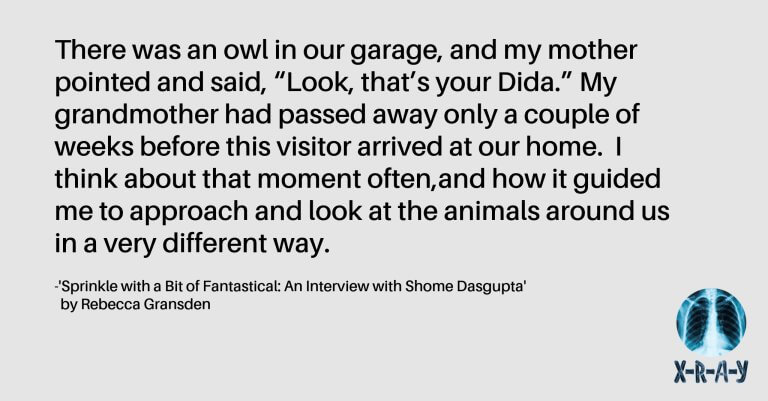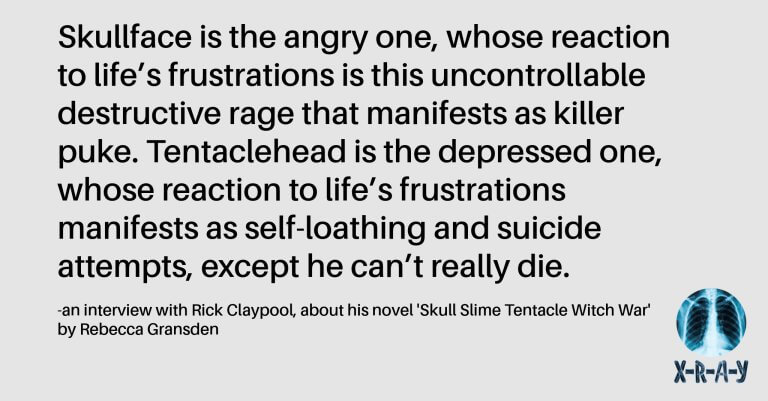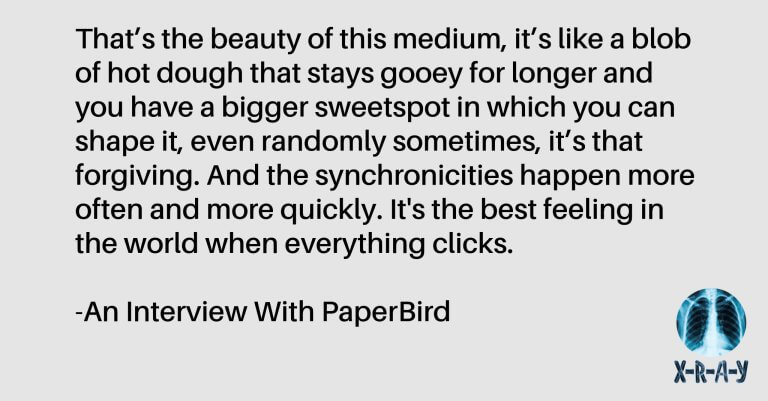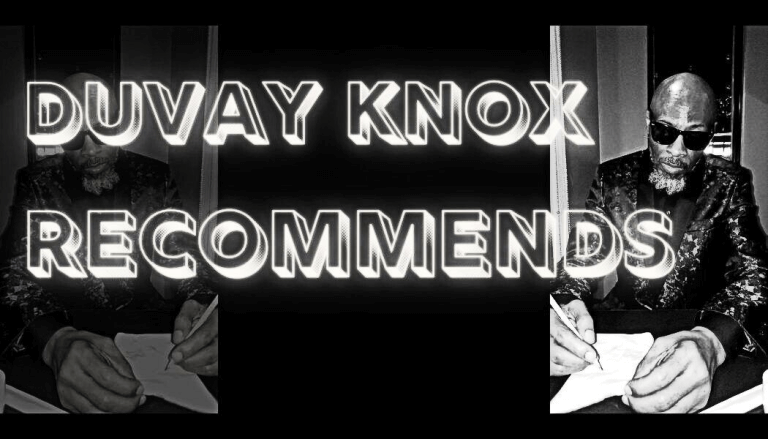
Interviews & Reviews


SPRINKLE WITH A BIT FANTASTICAL: An Interview with Shome Dasgupta

An Interview With Rick Claypool

TRANSMISSIONS: PaperBird
X-R-A-Y Literary Magazine: First things first. I'd like to personally thank you for saving my life.
PaperBird: (laughs) No problem. I have to do that once in a while. It's gotten to where no one comes to visit.
X-R-A-Y Literary Magazine: I was kind of anxious to see where you lived.
PaperBird: It's just a cottage, really. I built it a couple years ago with my brother. He's an architect, you know (not officially licensed). I think that was like his first real project.
X-R-A-Y Literary Magazine: But why out in a forest? Why so far away from society?
PaperBird: At first I thought it would be interesting, to pull a Thoreau or something, stay unplugged, but then I checked my finances and realized I had no other choice. Did I mention I have a Patreon? Just kidding. (It's a "Ko-fi" - https://ko-fi.com/paperbird)
X-R-A-Y Literary Magazine: Speaking of platforms, you're mostly known for your YouTube videos. Those wacky book reviews. How would you describe the channel to someone who is unfamiliar with what you do?
PaperBird: I guess you could say I make videos that dive deep into books but miss the mark completely and end up getting shattered a few feet away where the book and the author (if still alive) glance over, shake their head, sip their margarita, and nudge the sunglasses back up onto their face.
X-R-A-Y Literary Magazine: How long have you been at it -- "diving deep and getting shattered"?
PaperBird: The channel’s been around since 2014… woah, almost 10 years now! That's really sad. Masochistic, even.
X-R-A-Y Literary Magazine: We do get some whiffs of that, yes, but we'll get to your fetishes in a bit. At first you posted these very lofi rambling videos filmed in your car during what appeared to be your lunch break at work. I bet it was hot AF in the summer but figured after filming you’d come back in all hot and happy, high on your own supply.
PaperBird: (laughs) Exactly!
X-R-A-Y Literary Magazine: Are there any channels that influenced or encouraged you to start the project?
PaperBird: Not really, I started posting videos as an excuse to not continue writing in a traditional sense but still stay connected to books. Being on YouTube though I got hooked into watching knife review videos, especially ones made by Nick Shabazz. On his videos, he never shows his face, it’s just his hands holding the knife as he’s reviewing it. That inspired me to move out of the steamy in-car POV and adopt the same top down / table top style, except with books instead of knives, kind of as a joke.
X-R-A-Y Literary Magazine: Which of your videos would you recommend to someone who is new to what you do?
PaperBird: Here's a good sampler pack: Gary Lutz, Gerald Murnane, Jon Fosse, Pierre Michon, Claude Simon.
X-R-A-Y Literary Magazine: How do you go about selecting what to feature on each video?
PaperBird: It used to be as easy as grabbing the next book on the pile. I would read it a couple times, take some notes, talk about it on camera, then rinse and repeat. But over time I got tired of that, in fact now really dislike talking about books straight-on. It’s the same with the books I like to read -- the less hand-holding, the less information the better -- although in a “review” you kind of have to do that a little, give out information.
Now it’s more about building a container to dump in whatever's going on in my life, and somewhere along the way, an author or a book gets sucked in and spread out as the foundation. After a few months, if the structure holds, that load-bearing book (pun intended) becomes what is featured.
X-R-A-Y Literary Magazine: You used to publish short stories, poetry, and book reviews in more traditional places, maybe 15 years ago, under a different name, and if I had to guess, you still scribble in your notebook every day, though it's more a stream that feeds into whatever video is bubbling up, like background processing, am I right?
PaperBird: Yes, well… when things are flowing, creating the video feels similar to writing, actually it’s more rewarding because things can happen quickly, moving things around, sometimes you get this euphoric mix of imagery, music, and voice that couldn't possibly have been planned. I remember this review I did on Wilson Harris which I gave up on midway and instead turned it into a meditation on death. Maybe the method is more like abstract painting or DJ'ing.
X-R-A-Y Literary Magazine: Or like that show Iron Chef? Where the grandmaster would announce the theme ingredient and the contestants would use it to make their own original dish? The ingredient in your case being the book under "review."
PaperBird: Something like that, literature as seasoning on the larger animal inside that you want to serve up and knock people out with. Hit them with your own spices and herbs. That’s the beauty of this medium, it’s like a blob of hot dough that stays gooey for longer and you have a bigger sweetspot in which you can shape it, even randomly sometimes, it’s that forgiving. And the synchronicities happen more often and more quickly. It's the best feeling in the world when everything clicks.
X-R-A-Y Literary Magazine: You mention somewhere in Baby Penis, your autobiography, that your creative tendencies really took off when you were in high school?
PaperBird: That's right. I'd say around the time I was a sophomore. And I had the strangest motivation for writing. I wanted to impress a woman. I'm not going to say who… Let's just say she's a celebrity. (I reveal who she is in my Esther Kinsky video.) But yeah, I was very lonely and thought that if I wrote a novel -- I was fifteen at the time -- I thought that if I wrote a quality literary novel, at the age of fifteen, I would get recognized and become a celebrity, too, and that way She would know who I was. That's all I wanted in life then: to be recognized by this person whom I was obsessed with. We're talking Taxi Driver here.
X-R-A-Y Literary Magazine: Good thing you didn't kill anyone.
PaperBird: Yeah, it was only a teenage daydream, but a really strong one. Writing this novel was all that I thought about. And Her, of course. She became a muse or mother goddess, the "female personage" that Gerald Murnane writes about. I began to see Her in others. The girl who sat next to me in math class (Lauren). The girl who also liked to write, whose house I rode past on my bike almost every day (Kathleen). The girl I once slow-danced with whose perfume I would recognize even now (Angela). They all had brown hair and blue eyes. But can you see what else they had in common? It's all in the letters in their names, the colors of those letters… I still sometimes… I still search…
X-R-A-Y Literary Magazine: Hello? Hello… Earth to PaperBird… (snaps fingers) OK, let's pivot from that for a bit. For the techheads and aspiring booktubers out there, which single item of kit do you consider essential for the production of your channel?
PaperBird: You mean other than a knife?
X-R-A-Y Literary Magazine: Ah yes! I was hoping you'd get into that! For those of our readers who may not know, you have this penchant for cutting up your books with a knife on camera. Before we get into exactly why, let me just say, I've noticed that your knife handling skills have really improved over time. I remember early on, maybe it was the video on John Yau or Samuel Beckett, where it looked like you almost cut off your thumb. But then you're starting to hold the knife better, dare I say with more confidence, as you slice through your books. Are you trying to turn them into chapbooks or something?
PaperBird: It's a way of getting the weight down. Some of my compatriots on booktube -- Leaf by Leaf, Travel Through Stories, W.A.S.T.E. Mailing List -- they gravitate toward the chunkers. I like chunky shapes too. But after years of typing, cooking, crocheting, saxophone playing, whatever, my wrists blew out. Can't hold up anything weighs more than a Kindle now.
X-R-A-Y Literary Magazine: I ask because I think it was in the Sally Rooney video, where you go off on this 20 minute tangent just "deconstructing" one of her books, and I must say, the knife handling in that video was superb. You said you cooked? It was almost like you had worked in a butcher shop for years. And in the Gordon Lish video, where you chop off what appears to be your penis with a meat cleaver, just incredible, the way you handle both heavy and lightweight cutlery.
PaperBird: Thank you.
X-R-A-Y Literary Magazine: There's this one digression in the Fernanda Melchor video that I haven't been able to get out of my head. It's the part where the twins are starving and Fernanda has to get them food somehow, and so she goes on this long hunt through the forest...
PaperBird: Yeah, she's chasing some kind of unidentified animal. A boar, actually.
X-R-A-Y Literary Magazine: Right. And so she slaughters the thing and drags it all the way home, where she has to dice it up before dawn comes and the twins awake. And through the magic of editing, you show Fernanda Melchor skinning and chopping up and preparing this animal for over thirty minutes, and the overall accruing effect of the passage is just mind-numbing. It's like nothing I've seen before.
PaperBird: That's one of those digressions that demand a lot from the viewer but ultimately pay off in the end, I hope.
X-R-A-Y Literary Magazine: It was particularly exciting for me, all the details you worked in there about, for example, the sound of the animal's hide ripping, and the texture of the animal's striated muscles, and the way the tendons and ligaments would stretch on the bone and then snap off. I think the sound they made was "tCHew!"
PaperBird: Um, actually it was "tCHaw!"
X-R-A-Y Literary Magazine: Watching that video repeatedly and its attention to detail made me wonder if you've ever had any actual hands-on experience slaughtering animals. I mean, the scene with the blood caking on Fernanda's hands and all that, the shimmer of the freshly-killed animal's intestines -- it doesn't seem like you could whip that up from scratch.
PaperBird: Well, there was some research involved. I read a book on general swine anatomy, and then visited a meat market where the butcher was kind enough to let me observe. But the rest I pretty much made up, although I did dissect a cat in the eighth grade.
X-R-A-Y Literary Magazine: How big was it?
PaperBird: The cat? I'd say about a foot and a half.
X-R-A-Y Literary Magazine: The reason I'm wondering is because I happen to work with animals. Mostly dogs and cats, but sometimes deer, possums, and armadillos. They're usually dead by the time I get them, or rapidly reaching that state, so I'd say I know more than your average joe about the death of animals. And let me be the first to attest to the accuracy of your scene concerning the boar's death and dissection in the Fernanda Melchor.
PaperBird: Thanks. (laughs) What is it you do exactly? Aside from working for X-R-A-Y Literary Magazine?
X-R-A-Y Literary Magazine: I guess you could say I'm a type of artist, or what some would call a "roadkill artist." Basically, I drive around interstates and highways and look for animals that've been run over or knocked dead by cars. I take the animals home and hack off as much meat as I can without damaging their skeletons, and then boil the rest off their bones.
PaperBird: Not for eating purposes, I hope.
X-R-A-Y Literary Magazine: (laughs) No, no. I'd say it's fairly dangerous to eat roadkill. What I'm interested in are their bones -- the ones that haven't been shattered or splintered by the impact. Sometimes the cars do so much damage I can only extract about 20% of their bones intact. Usually they're the small ones, like the carpals or patellas, but every once in a while I'll be able to get a whole femur or pelvis. Complete skulls are hard to come by, and always require that I drain the brain out through the nostrils.
PaperBird: No kidding.
X-R-A-Y Literary Magazine: The key to working with dead animals is to get to them before rigor mortis sets in. That way you'll cut your flaying time in half. And it's always important to know where the bone is in relation to the muscle, so you won't accidentally cut in too deep and make abrasions on the bone's surface. Usually I just feel for the bone and leave about a centimeter of meat on and throw the whole thing into a vat of boiling water. I have these vats at home for this purpose. They loosen up the muscles and tendons and kill off any bacteria. Then you just slide the meat off and you're left with clean bone. In my younger days, I used to just snap it off, like Fernanda did in the video, but I found that doing that'll strip away some of the outer layer, or what's called the periosteum. The ligaments did make a sort of tCHaw! sound when I ripped them off, though. Actually it was more of a tCHwee!
PaperBird: tCHwee?
X-R-A-Y Literary Magazine: Right. I guess the exact sound would depend on what ligament you're dealing with, but I think it was a tCHwee!
PaperBird: Hunh.
X-R-A-Y Literary Magazine: Anyway, getting back to what I was saying. Once you get all the muscle and connective tissue off the bone, you'll want to paint a coating of enamel over the surface in order to preserve it, keep it from deteriorating. Maybe also add a layer of glossy white paint to give it that clean look. I've heard of some roadkill artists working in ceramics. It's up to the individual. Myself, I like having a clean and durable bone because I work with furniture. That is, I make furniture out of bones. I've made tables, chairs, dressers, beds, and footstools. Once, I built a staircase for a friend of mine. That one took a couple years and an insane amount of roadkill. I practically had to drive cross-country for that one. And you can see why it's important, when building furniture, to want a bone that isn't splintered or damaged in any way. Especially for something like a staircase.
PaperBird: I see.
X-R-A-Y Literary Magazine: But there're probably limits to how much roadkill you can find in a given year. Sometimes driving around I'll get as many as two or three a day, freshly-killed. Then it might take weeks before I find another roadkill, and it might just be a bird or a squirrel. Which makes things hard for me because lately I've been getting lots of offers from clients. They want maybe a throne of bone by the end of the month, or some sort of man-sized bird-cage or what have you. They can get really specific, and that's totally appropriate because everything I make is custom-designed. Hand-crafted. I think the price is fair, and I always give a one-year service warranty. But lately I've just gotten too many offers. I only have so many resources stock-piled in my vault. Can you see my predicament? It doesn't help asking my friends and neighbors if I could have dibs on their pets after they die. Their pets, that is. But right now, I'm in the process of cutting a deal with a veterinarian who happens to like what I do, so there's some hope for me yet. And the other day I got contacted by a record-company who wants me to build an elaborate canopy-style bed that can be used to promote this death-metal band's next album. Have you heard of Sarcophagi? I think that's their name.
PaperBird: Not a fan.
X-R-A-Y Literary Magazine: But you know the name? I'm hoping this'll give artists like me the kind of exposure we need. Not that roadkill artists have an alliance or anything. I think we just need some credibility and recognition because things're really hard for us. I live out on a farm in Minnesota with a few of my carpenter friends. We built the place ourselves. They're all sort of marginal artists like me: Sherry makes Egyptian-style caskets out of papier-maché, Trent works with rubber, Steven's an engineer in roller-coaster design but so far no amusement park will contract his work because they think his stuff's "unethical." But what can you do? You just plug away at it and hope that something good'll eventually come out. That's my advice to young artists: never take the easy road and never give up. As long as you remain true to your work, keep your work genuine, you'll be all right. There will always be times when you really doubt yourself, like when you're not eating as well as you should be because you can't afford anything besides microwave dinners and corndogs, and you're working at the IRS or for some low-circulation magazine or newspaper writing soft journalism and counting down the days to your next paycheck, and you have no love- or sex-life because you don't have the time or energy for that kind of thing, although you really do want one, it's all you think about, having an understandable and caring person be there for you, to buffer the pain and constantly tell you that you're not alone in this world, and you wonder to yourself, Are these sacrifices I'm making truly worth it? Am I putting out anything into the world that will make it a better place -- or that will help me be remembered after I die? Will I ever achieve the sort of recognition I honestly think I deserve in this lifetime, or at all? Or am I just going to have to fantasize about it in very strange and elaborate ways? Is it worth it to even go on with my life? Sometimes you'll think that the world doesn't need another someone like you, another dreamer, another hopeful who for some reason couldn't make it and is relegated to a life of mediocrity, who doesn't make an iota of a dent along the passage of time, and passes easily through the anus of history as if they never existed. But you just have to keep at it. Even if your spiritual back is broken, even if you're down to your last can of Spam, even if you've wasted away to 120 pounds when you really should be 160, even if you truly are all alone in this world, you just have to pick yourself up and reach for the next bone.
PaperBird can be found on YouTube: www.youtube.com/c/PaperBird

TRANSMISSIONS: Books of Some Substance

TRYING TO FIND SOMETHING BETTER: An Interview with Steve Gergley

TRANSMISSIONS: Another Fucking Writing Podcast

LOSS, GRIEF, SADNESS, MAGIC: An Interview with Bradley Sides

LOVE IS A SHITPOST FROM THE SOUL: A Profile of Cash Compson by K Hank Jost

